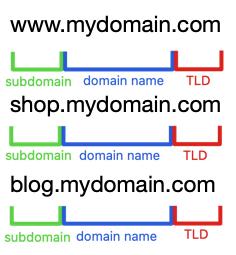What is a domain?
A domain is a unique address that identifies a website on the Internet. It allows users to find and access a specific website. Before the existence of domains, it was necessary to access a website by directly entering its IP address. With the advent of domains, this situation changed, and instead of using the IP address, we started using the chosen domain.
Domains consist of a name and an extension (such as .com, .org, .net).
Components of a Domain:

- Domain Name: The customized and specific part, like "mydomain" in “mydomain.com.” It is one of the most important parts by which users will know you, so it is important to be clear about the desired name or what you want to convey/achieve with that name.
- Domain Extension (TLD): Also known as TLD (Top-Level Domain), it is the part that follows the name, such as ".com", ".net", ".org", ".es", ".cat", etc. There are several types of domain extensions (gTLD, ngTLD, ccTLD, and third-level), although the functioning of the services associated with the domain will not vary with the chosen TLD, the requirements and operation of the domain itself may vary. For example, it is common for territorial extensions (ccTLD) to require the contact person to have a presence in the specific country.
Subdomain
Creating subdomains allows you to organize different sections of a website or create sites related to the main domain. For example:

- www.mydomain.com: Main website. (Web application, such as WordPress)
- shop.mydomain.com: Online store for the business (Web application, such as PrestaShop)
- blog.mydomain.com: Website with help guides.
Functions of a Domain:
- Website: Host a web page with information about our business, an online store, a management system, etc.
- Email: Create customized email accounts with our own domain (Example: info@mydomain.com).
- Easy Access: Allows users to access a website through an easy-to-remember address instead of using a numerical IP address.
- Identity and Branding: Helps define the identity of a website and email accounts, and is crucial for a company or organization's online branding and presence.
- Web Traffic Management: Domains can point to specific servers using DNS records, managing how and where user requests are directed. In summary, a domain is a unique and readable address that allows access to a website on the Internet, facilitating navigation and identification.
Which entities are involved in the process?
- ICANN: This is the organization responsible for allocating Internet Protocol (IP) address space, protocol identifiers, and the functions of managing the domain name system, as well as administering the root server system. In summary, the organization that manages the functioning of the Internet.
- Registries: A Registry is the entity that manages one or more specific extensions, for example, Verisign manages the .com, .net, .cc, and .tv extensions.
- Registrars: The registrar is the company that manages the registration of the domain and manages it for the duration of that registration, for example, us.
- Resellers: The reseller is a third party or company that resells a service from another third party.
- Registrants: The registrant is the owner of the domain, i.e., the individual or company that completes the registration.



